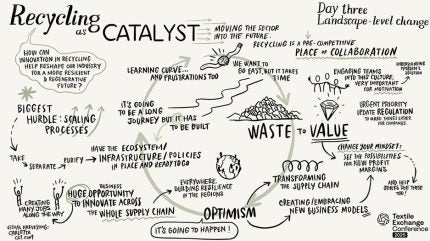
On the final day (day three) of this year’s Textile Exchange conference, the sessions were designed to share ideas on advancing landscape-level transformation that accounts for complexity, responds to lived realities and delivers impact across climate, nature and livelihoods.
During the opening session, Visionology founder Chris Denson spoke to Reju CEO Patrik Frisk and Circ CEO Peter Majeranowski about how we’re at a watershed moment for innovation in textile-to-textile recycling.
Attendees heard how new large-scale recycling plants across Europe can mine waste instead of natural resources and reintegrate it back into the supply chain.

Discover B2B Marketing That Performs
Combine business intelligence and editorial excellence to reach engaged professionals across 36 leading media platforms.
The trio agreed that technological innovation alone isn’t enough. To fully unlock its potential, it needs to be paired with upstream innovation and the right policies while creating an ecosystem that can efficiently collect and sort textiles.
Four key takeaways from Textile Exchange conference day 3
1) Hotspot analysis is the entry point for landscape-level action
Panelists spoke of the need to identify environmental and social “hotspots” within supply chains as a crucial first step toward implementing landscape-level solutions – enabling nature-positive outcomes on a larger scale. Attendees heard how this approach enables companies to see where fashion’s footprint overlaps with the world’s most critical ecosystems, so efforts can be prioritised where they are most needed and most likely to drive measurable impact. By integrating science into decision-making and pinpointing these areas early, businesses can align sustainability strategies with real-world conditions, setting the stage for context-specific, collaborative interventions that support both nature and communities.
2) Collaboration is essential for scalable, context-specific solutions
Effective landscape-level action depends on inclusive, participatory approaches. Attendees heard how having the right stakeholders in the room and identifying their roles can help enable effective projects that reflect local realities and deliver tangible outcomes. When it comes to recycling, this includes the collectors and sorters on the ground, who could offer fresh insights from their perspective of interacting with the materials on a daily basis. These methods move beyond one-size-fits-all models, ensuring interventions are both contextually relevant and impact-driven. Panelists discussed how successful partnerships make landscape-level collaboration not only meaningful, but more feasible, and more likely to succeed in the long term.
3) Equitable economic models at Tier 4 are vital for long-term supply chain resilience
A running theme of the conference has been how we can effectively confront and distribute the up-front cost of transitioning to preferred material production systems, ensuring premiums reach those at Tier 4. Attendees heard how equitable models must account for everyone who is needed to make that system possible, from the livelihoods of farmers changing their practices to the waste collectors fueling the potential future of textile-to-textile recycling. Embedding equity at the raw material level helps build resilient landscapes and supply chains and ensures that those most connected to the realities on the ground are central to decision-making and benefit-sharing, simultaneously helping to foresee and prevent any unintended consequences that could come with changing the status quo.

US Tariffs are shifting - will you react or anticipate?
Don’t let policy changes catch you off guard. Stay proactive with real-time data and expert analysis.
By GlobalData4) Data breakthroughs have been made-now it’s time to scale
Real progress has been made in the awareness of data’s importance and the collection of both reliable traceability and impact data. However, attendees heard how the industry continues to face traceability challenges such as fragmented systems, inconsistent data quality, and limited supplier capacity to meet new demands. We now need harmonised frameworks and clearly defined roles for tech providers, regulators, and standards bodies to scale effective data solutions across the supply chain. However, panelists shared that meaningful breakthroughs don’t wait on perfect data conditions-they start with people willing to act despite the gaps.





